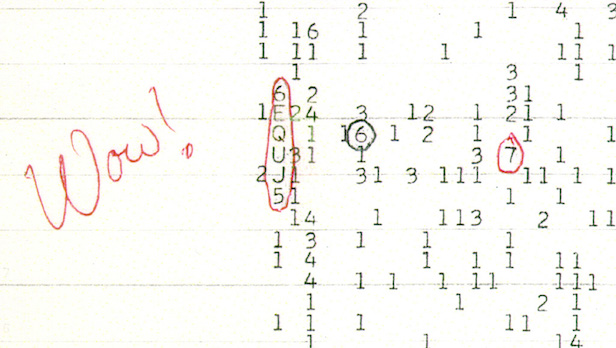‘Wow!’ signal mystery finally solved
This signal detected in 1977 had gone unexplained until now, as scientists now confirm it’s from a comet

This is the original computer printout from 1977. Image credit: Big Ear Radio Observatory & North American AstroPhysical Observatory (NAAPO)
The elusive ‘Wow!’ signal discovered forty years ago has finally been explained. Astronomers prove that the signal originated from a comet, and not from extraterrestrial life.
In August 1977, astronomer Jerry Ehman noted an unusual signal from the sky observed by the Big Ear Radio Observatory (BERA) in Ohio, United States. This signal really stood out from the rest, so Ehman put a ring around the code and jotted the famous ‘Wow!’ next to it. This 72-second-long signal caused a fair amount of confusion, as scientists ruled out the possibility of it originating from asteroids, exoplanets, stars and even interference from Earth itself. It has long been speculated that the signal might have even come from extraterrestrial life.
Fast forward to the present, and in 2016 the Centre for Planetary Science (CPS) proposed the hypothesis that the source for the signal was in fact a comet. More specifically it’s the hydrogen cloud accompanying a comet. Researcher Antonio Paris of St. Petersburg College, Florida, United States, and his team determined that there were two comets that passed that particular region of the sky at the time of the observation. These comets, 266P/Christensen and P/2008 Y2 (Gibbs), explain why the signal was never seen again, as they are always on the move.

These icy bodies release gases as the Sun warms their surface this is what caused the hydrogen cloud. Image credit: ESO/E. Slawik
Using a 10-metre telescope, Paris and his team analysed the Comet 266P/Christensen and concluded that the signal matched the one found by BERA all those years ago. The only difference in signals is that the one discovered forty years ago was much stronger, which can be explained by the difference in telescopes used. Paris and his team used a telescope roughly five times smaller than BERA. With a greater light gathering capability in 1977, it is no surprise the comet signal was stronger. Furthermore, when comets reach the inner Solar System they tend to lose mass, meaning Comet 266P/Christensen would have been much larger back in the day.
Paris cannot yet confirm that the ‘Wow!’ signal originated from Comet 266P/Christensen, however they can safely say that this was created by a natural phenomenon, most likely a comet.
UPDATE: Since this story was published, a rebuttal has been released. Read the statement here: http://naapo.org/WOWCometRebuttal.html
Keep up to date with the latest space news in All About Space – available every month for just £4.99. Alternatively you can subscribe here for a fraction of the price!




